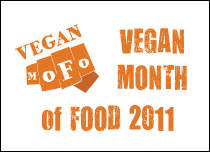Vegan MoFo day 24: Filipino fare
By Erinwiko on Oct 24, 2011 | In Food porn | 5 Comments

I was super excited to come home from work today to find a surprise waiting for me- my copy of Vegan Pie in the Sky! I loved testing for this book, and I’m beyond excited to see others falling in love with the same recipes that I did. There was no better way to celebrate than by baking a pie, of course.
But I have a theme to keep t0! Luckily I know of one place in the world where pie is a street food- the Philippines.
Buko is Tagalog for young coconut- the main ingredient of this pie. Buko pie is common in the southern regions of the province of Laguna- where I lived and volunteered with Bahay Tuluyan, an organisation working with children in need of special protection, a few years ago. No jeepney ride from the children’s shelter, near Los Baños, to Manila would be complete without we volunteers picking up a buko pie on the way. The best part- we never had to leave the jeepney, as there would always be someone selling pies through the window. Buko pie made the long, uncomfortable drive a lot more bearable.
For this pie, I used the buttery double crust recipe from Vegan Pie in the Sky, filled with a mixture of young coconut ‘meat’, coconut water, Soymilke condensed milk (which, by the way, is glorious) and cornstarch. It’s a simple pie, but with a lot of memories.
But never fear, despite my excitement about the arrival of the pie book, we didn’t have pie for dinner. I opted for a full Filipino night, with another recipe from Terry’s test kitchen.
This adobo was beautifully authentic, tasting just like something that the house mothers at Bahay Tuluyan would have made- were they vegan. As I ate adobo at least two or three times per week while I was in the Philippines, this was a great, comforting reminder of how great often-neglected Filipino cuisine can be.
Needless to say, I’ll be cooking with fervour from this book when it’s released- until someone else can offer me a Filipino fix this good.




















